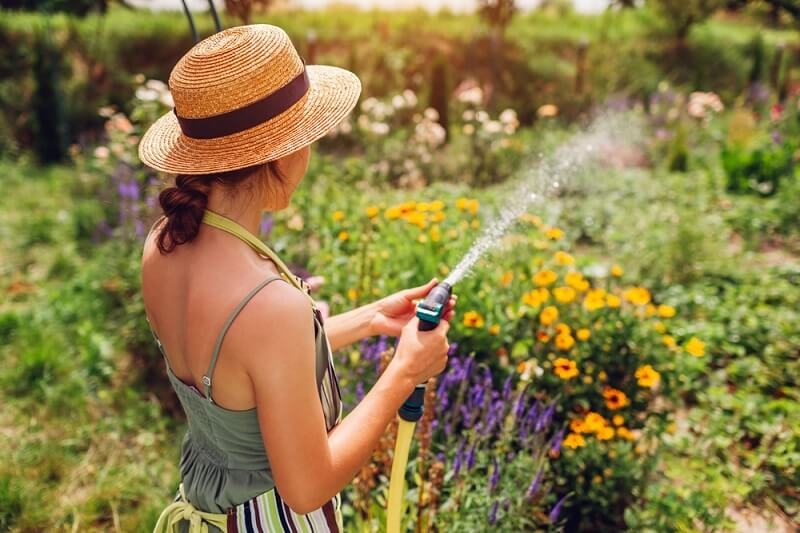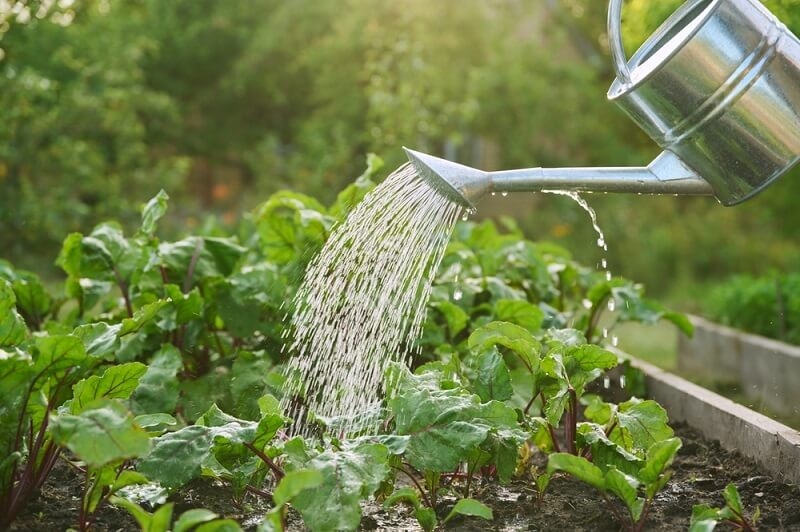Watering Plants with a Complete Guide to Healthy Gardening

Gardening care begins with one of the most basic activities—watering plants. Be it indoor succulents, a vegetable garden, or outdoor flowers, knowing how to water plants optimally can either make or break your garden's success. A wise balance between finding the optimal watering routine for flowers and learning to never overwater leaves your greens healthy, vibrant, and thriving throughout the year.
This ultimate guide dissects all you need to know—ranging from identifying under-watered plants to using a beginner's drip irrigation guide and being green with water-saving watering techniques that ensure your garden still looks fantastic.
Why Watering Plants the Right Way Matters
All plants, however robust or fragile, depend on water as their sustenance. It powers nutrient uptake, assists with photosynthesis, and controls temperature in the plant. Still, overwatering or underwatering can harm roots, cause leaves to wilt, and inhibit growth.
Proper watering, when executed correctly, enables plants to grow robust roots, be disease-resistant, and flower for longer periods. Knowing how, when, and how much to water guarantees your plants don't merely exist—they flourish.
Understanding the Science Behind Watering Plants
Watering is not just about adding liquid to dirt. It's about helping plants absorb what they need most effectively.
- Root Zone Moistening: The goal is to wet the entire root zone—not just the surface. Watering deeply encourages roots to grow downward, strengthening the plant.
- Soil Texture: Sandy soil drains quickly and requires more frequent watering, whereas clay soil retains water longer and can lead to root rot.
- Plant Type: Cacti and succulents require less water, while vegetables and tropical plants prefer to stay in moist soil at all times.
- Weather Conditions: Hot, dry days result in a greater loss of moisture, while cooler, humid days require less moisture.
If you understand these factors, you will be able to develop the best watering schedule for flowers and other types of plants within your garden.
The Best Watering Schedule for Flowers
Finding the right watering schedule for flowers involves considering their type, the soil, and the environment. However, there are some basic guidelines to keep most blooms healthy and flourishing.
- Watering in the Morning: Early mornings are best because the soil has a chance to soak up water before the sun gets hot, minimizing evaporation.
- Deep, Infrequent Watering: It's more beneficial to water deeply two or three times a week rather than sprinkle lightly daily. Deep watering gets to the roots, rather than the top.
- Seasonal Adjustments: Spring and summer flowers tend to require more water, while fall and winter flowers might get by with less frequent watering.
- Container Plants: Pots evaporate moisture more quickly than garden beds—check moisture levels daily in hot months.
Having a routine provides plants with regular watering without sogginess, and brings petaled color to life, adding strength to stems.
How to Avoid Overwatering and Keep Roots Healthy

One of the top gardening blunders is being a little too loving, especially with water. Knowing how to avoid overwatering is vital to prevent wilting leaves, root rot, and reduced growth.
Tips to Avoid Overwatering
- Check your soil before watering. Stick your finger into the soil about an inch deep. If your finger feels moist, wait a day or two.
- Ensure your pots drain properly. Avoid pots without drain holes and soil that is too compacted, as the water has to drain and not drown roots.
- Buy a moisture meter. An inexpensive moisture meter can assist in intentionally checking the soil moisture.
- Check the weather. You can skip watering altogether when it rains, and maybe wait till next week to water your plants when it is cooler or cloudy.
Remember: plants can bounce back from moderate dryness, but not waterlogged roots.
Recognizing the Signs of Under-Watered Plants
Lack of water can be just as harmful, though. If you can identify the signs of under-watered plants sooner rather than later, it can help you avoid leaving your plants to go into permanent stress.
Common Signs Include:
- Droopy Leaves: Droopy or limp leaves are usually the most typical signs of dehydration.
- Soil Dry and Crumbly: If the soil looks dusty and pulls away from the edges of the pot, it's time to water.
- Leaves with Brown Edges: Leaves that are withered at the tips and edges usually indicate a period of no moisture.
- Slow Growth, Bud Drop: A dehydrated plant might drop buds and cease growth altogether.
Water deeply and slowly to remedy the issue, allowing the water to permeate into the root zone. If you mulch the soil to retain moisture, it will be less prone to rapid evaporation.
Drip Irrigation Guide for Beginners
Drip irrigation is an excellent option for beginners who are ready to get serious about their watering program. This will water plants directly at the roots through tiny tubing or emitters, which helps reduce waste and deliver a consistent amount of water to your plants.
Drip Irrigation Advantages
- Water Efficiently: Because they deliver water directly to the root zone, water can be used thoroughly with minimal runoff and evaporation.
- Time Savers: With drip irrigation, you have a system that waters for you, which means hands-free watering!
- Better Plants: Since drip irrigation systems deliver consistent levels of moisture without over-watering.
- Flexible: This system works great in greenhouses, vegetable gardens, or plants on a balcony.
Simple Setup Steps
- Design Your Pattern: Plan the placement of emitters according to the location of plants.
- Install the Tube: Use a regulator and attach the main tube to your water supply.
- Mount Emitters: Locate them close to the root zone of each plant.
- Test the System: Turn it on and test for uniform flow.
Once you install it, you'll discover drip irrigation to be one of the most cost-effective and environmentally friendly watering systems available nowadays.
Eco-Friendly Watering Methods for Sustainable Gardening
As water becomes an increasingly valuable commodity each year, eco-friendly watering systems are essential for sustainable gardening. By conserving water and minimizing waste from watering, you can maintain a lush and green garden while also helping to protect the environment.
Top Eco-Friendly Watering Methods
- Rainwater Harvesting: Set up rain barrels to tuck away rainwater for future use. Simple to implement, the plants will not be harmed. promote vegetation.
- Greywater Utilization: Utilize clean sink or laundry water (avoiding water contaminated with toxins), in order to water outside the vegetable garden.
- Mulching: Use natural mulch, like straw, to conserve moisture in the soil.
- Smart Irrigation Timers: Consider installing timers for production watering to be more sensitive to weather changes in order to adjust the frequency of watering.
- Use Native Plants: Use plant varieties that are native to your climate (native plants will generally need less watering).
If you can take these principles into account, you will decrease your overall impact while watering your plants and maintaining them in a healthy state.
How to Create a Personalized Watering Plan
Designing a successful watering plan will rely on observation, repetition, and modification. T
Create your watering plan:
- Consider your soil type: Sandy soils require more frequent watering than clay soils, as clay can retain moisture for longer periods.
- Know your crops: If possible, try to group crops with similar needs together (e.g., plant tomatoes with tomatoes, not with cucumbers).
- Flowering plants are watered at one time and succulents at another.
- Observe the weather: Water less so during long rainy spells or consistently hot/foggy periods.
- Use Tools: Tools such as moisture meters, smart sprinklers, and rain gauges can make the process easier.
- Set a Schedule: Adhere to a schedule while remaining flexible to incorporate feedback.
This specialized approach ensures that every drop is used effectively, watering your plants appropriately without wasting a drop.
Watering Indoor vs. Outdoor Plants
Indoor and outdoor plants have vastly different watering needs. Just knowing their specific needs will help you avoid the problems caused by over- or under-watering.
Indoor plants.
- Water when the top inch of soil feels dry.
- After watering, make sure the pots drain well.
- No indoor plants should sit in water in saucers below their pots.
- For tropical indoor plants, increase humidity with mist (but not cold) or pebble trays.
Outdoor Plants
- Water in the morning to minimize evaporation.
- Apply drip or soaker hoses for uniform coverage.
- Water more often but less deeply during hot weather.
- Mulch protects roots and helps keep them moist.
Maintaining temperature and outdoor and indoor watering methods balances your garden's overall health.
Seasonal Watering Tips
Watering plants isn't a one-size-fits-all situation—it varies by season.
- Spring: Water gradually as temperatures warm and plants start new growth.
- Summer: Water thoroughly and early in the morning. Water more often for flowers and vegetables.
- Fall: Gradually reduce watering as plants shift into dormancy.
- Winter: For most plants, cut back dramatically; only water when the soil is arid.
Adjusting your schedule seasonally avoids shock and accommodates natural growth cycles.
Smart Tools to Make Watering Easier
New gardening presents easy tools to make watering simpler:
- Automatic Sprinklers: Suitable for large gardens or lawns.
- Smart Irrigation Systems: Regulate watering according to soil moisture and weather conditions.
- Moisture Sensors: Avoid overwatering by monitoring soil conditions.
- Pots That Water Themselves: Best suited for travelers or people who are busy.
These tools help ensure consistency and accuracy, both of which are essential for healthy plants.
Troubleshooting Common Watering Mistakes
Mistakes happen, even for the most seasoned gardeners.
Below are solutions for watering issues:
- Too Frequent Watering - Always allow the soil to dry down to minimize fungal growth.
- Neglecting Drainage - Ensure, again, that watering occurs into the proper soil and drainage while the plant is in the pot.
- Watering Only (the) Surface - Always water deep enough to get to the roots.
- Water that Scalds the Roots/Water that is Too Cold - Always keep water at a consistent room temperature.
- Cold water may shock roots.
Fixing those bad habits will mean your plants will soon grow healthier and greener.
Conclusion: Mastering the Art of Watering Plants
Learning the skill of watering plants takes practice, patience, and dedication.
Once you employ the best watering schedule for your flower arrangements, understand how to manage overwatering, identify the signs that your plants are under-watered, learn about using drip irrigation, and educate yourself on eco-friendly watering approaches, you will be able to master the skill of watering plants to maintain a happy, healthy, sustainable garden that flourishes throughout the season.
No matter how green your thumb is, heed this one simple fact: the correct amount of water—at the proper time—can elevate your plants from great to magnificent.
This content was created by AI

